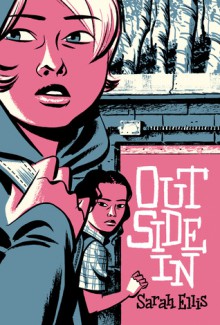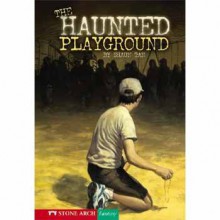
Sarah Ellis' Outside In is her seventeenth novel for young readers, and readers who discover her through this unusual work will undoubtedly be keen to investigate her backlist.
The cover captures the hint of mystery which lurks beneath the story, for Lynn encounters Blossom and immediately questions present themselves.
"Either this extremely ordinary-looking person in a school uniform was a nutbar, or the world had become like one of those fantasy trilogies that Shakti liked to read and which were Lynn’s least favourite books. Maybe this person was a glurb and she had an amulet that had to be restored to the true Druid princess or some such, and wouldn’t it just be Lynn’s luck if it turns out by some horrible cosmic joke that the world was really like that. She would have to go and lie down in the tundra somewhere and just give up."
There are some humourous touches like that, too, as Lynn tries to make sense of what she is seeing. And, along the way, some social commentary. How does one define real in a world which is dominated by the virtual?
"Did Blossom and her family really exist? Lynn experienced a wave of doubt as she glanced around before running her key across the metal screen at the edge of the reservoir. No Phone. No email. No street address. Did Blossom even have a last name? For Pete’s sake, it would be easier to confirm that Celia’s guinea pigs, stars of their own YouTube movies, existed."
Blossom doesn't leave a trail behind her which is easy for Lynn to spot and contemporary readers will face the same challenges following her breadcrumbs. Is she a fantastic creature of sorts? Or does she just live her life in a way which seems fantastic to onlookers living in a mainstream existence complete with pets on YouTube?
"We reorder things. We collect recycling and take it back to where it is useful. We pull up weeds and put them in the compost where they turn into dirt to grow more things. And something we just fancy things up."
These are not fantastic concepts to be sure. But there is some complex thinking behind these everyday save-the-Earth aspects of the story.
"“The game’s not worth the candle.”
“What does that mean?”
“It’s from card games from long ago. The chances of winning are not worth the cost of burning a candle to light the game.”
And along the way, a number of valuable issues are raised. Out of context, these quotes could suggest that the book is preachy, but that's not the case.
“But there are so many things in the world already. Did you know that there is a billion square feet of self-storage in America? That’s a billion square feet of stuff that nobody is using. There are already enough things without making new ones. We can just use what we’ve got. Fix it and use it. All this racing around earning and shopping and saving. It’s all just dancing for doughnuts.”
There is perhaps an overly-wholesome feel to some of the story's language ('nutbar' and 'for Pete's sake' hearken to the 1950s kids' books I grew up reading) but the talk of candles and games is embedded solidly in story.
As an introduction to this critically acclaimed author's works, it is an impressive ambassador.
This review originally appeared on BuriedInPrint.


 Log in with Facebook
Log in with Facebook 









